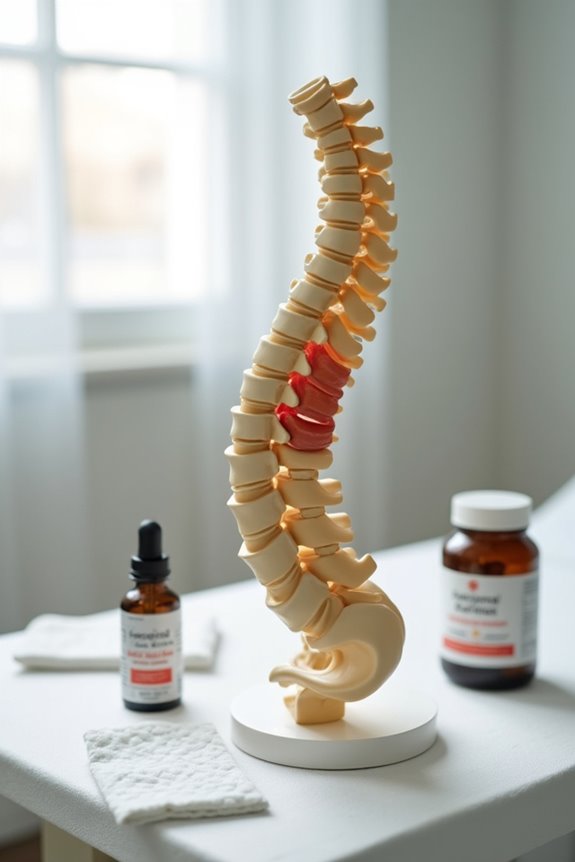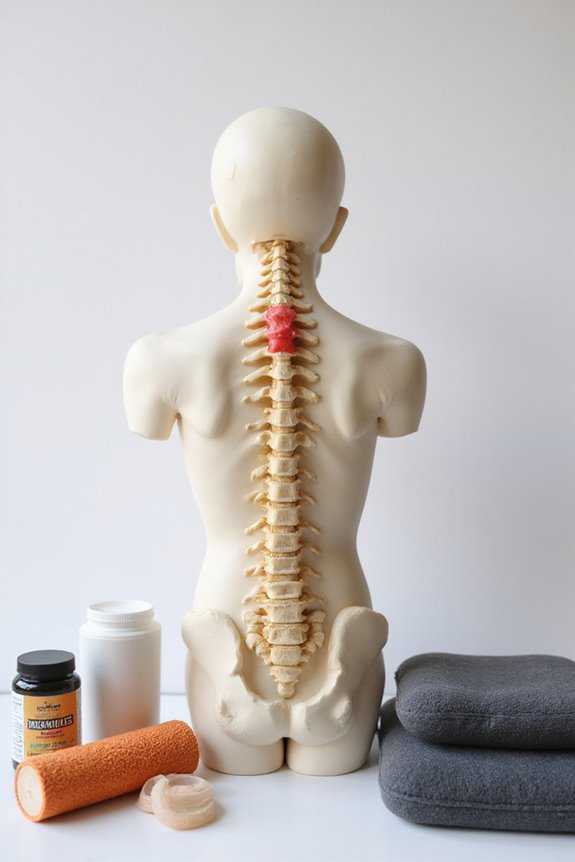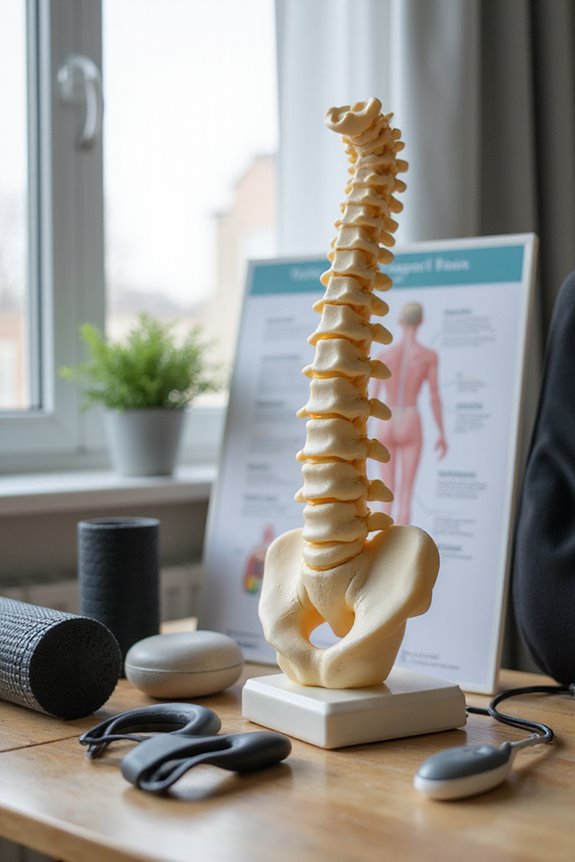Lower back pain commonly arises from multiple factors, including:
- Muscle and Ligament Strain: Results from overstretching or tearing, causing pain and stiffness.
- Degeneration of Spinal Components: Age-related wear impacts disc hydration and elasticity.
- Herniated or Bulging Discs: Occurs due to nerve compression from disc displacement.
- Trauma and Injury: Sudden movements or accidents lead to sprains or fractures.
- Inflammatory Conditions: Disorders like ankylosing spondylitis cause significant discomfort.
Further insights into these causes are beneficial for understanding effective management.
Key Takeaways
- Muscle and ligament strain from overstretching or tearing can lead to localized pain and stiffness in the lower back.
- Age-related degeneration of spinal components, such as discs, decreases hydration and elasticity, contributing to lower back pain.
- Herniated or bulging discs may cause nerve compression, often resulting from aging, poor posture, or repetitive strain.
- Trauma and injury, including sprains and fractures, are significant causes of lower back pain from physical activities.
- Inflammatory conditions like ankylosing spondylitis and rheumatoid arthritis can lead to chronic lower back pain, especially in younger adults.
Muscle and Ligament Strain
Muscle and ligament strain in the lower back is a prevalent condition that can greatly impact daily activities and overall well-being. Such strains occur from overstretching or tearing of muscle fibers and ligaments, often due to improper lifting, sudden movements, or repetitive motions. Symptoms include localized pain, stiffness, and muscle spasms.
To promote muscle recovery and strain prevention, individuals are encouraged to:
- Practice proper lifting techniques.
- Engage in regular strength training for back and abdominal muscles.
- Maintain a healthy weight to reduce strain on the lumbar region.
- Avoid prolonged sitting and guarantee ergonomic postures during activities.
Early medical intervention and physical therapy can considerably reduce recovery time and minimize the risk of chronic pain. Effective management strategies, such as using heating pads for pain relief, are essential for long-term well-being.
Degeneration of Spinal Components

Degeneration of spinal components represents a significant concern in the domain of lower back pain. This condition primarily results from age-related wear and tear on spinal discs, leading to decreased disc hydration and spinal elasticity.
- Disc Hydration: Over time, spinal discs lose hydration, resulting in stiffness and shrinkage.
- Spinal Elasticity: The elasticity of the discs diminishes, impairing their ability to absorb mechanical stress.
Degeneration is common after age 40, with most adults exhibiting signs of disc wear. Contributing factors include reduced nutritional supply and genetic predispositions, alongside lifestyle choices such as smoking and obesity. As these discs degenerate, they may provoke inflammation and irritation of nearby nerves, contributing to persistent back pain and discomfort. Understanding these dynamics is essential for effective management and prevention strategies. Additionally, using heating pads for pain relief can provide soothing warmth that alleviates discomfort associated with degeneration.
Herniated or Bulging Discs

Herniated or bulging discs are prevalent conditions that considerably contribute to lower back pain. Understanding disc anatomy is essential; intervertebral discs consist of a tough outer ring (annulus fibrosus) and a soft center (nucleus pulposus).
- A herniated disc occurs when the nucleus pulposus leaks through a rupture in the annulus fibrosus, potentially causing significant nerve compression.
- In contrast, a bulging disc extends beyond vertebrae without rupture, yet may still impinge on nearby nerves.
Both conditions often result from natural aging, poor posture, or repetitive strain, leading to discomfort and neurological symptoms such as sciatica. Effective diagnosis, typically via MRI or CT scans, is vital for appropriate management and treatment. Additionally, using a heating pad for pain relief can help alleviate discomfort associated with these conditions.
Trauma and Injury

Trauma and injury serve as significant contributors to lower back pain, encompassing a range of conditions that can arise from various physical activities.
- Sprains and Strains: Result from improper lifting or sudden twisting, affecting ligaments and muscles. Symptoms include pain, spasms, and mobility issues. Treatment often requires rest and physical therapy.
- Vertebral Fractures: Commonly occur after traumatic accidents, like falls. These fractures may impinge on nerves, causing neurological deficits. Imaging studies are essential for diagnosis.
- Work-related Injuries: Approximately 38.5% of work-related musculoskeletal disorders involve back injuries from trauma. Ergonomic improvements and safety training can reduce risks.
- Chronic Pain: A portion of patients may experience chronic lower back pain post-trauma, necessitating ongoing assessment and multidisciplinary treatment.
Inflammatory and Arthritic Conditions

Inflammatory and arthritic conditions represent a distinct set of factors contributing to lower back pain, differing markedly from trauma and injury-related issues. Inflammatory back pain (IBP) often affects younger adults and is characterized by symptoms such as morning stiffness lasting over 30 minutes and pain that improves with movement.
Key conditions include:
- Ankylosing spondylitis, which primarily targets the spine and sacroiliac joints.
- Rheumatoid arthritis, occasionally affecting the lumbar spine.
- Psoriatic arthritis and enteropathic arthritis, associated with inflammatory bowel disease.
These conditions involve an autoimmune response, leading to inflammation and potential tissue damage. Approximately 23% of adults experience chronic lower back pain, with a significant subset stemming from these inflammatory and arthritic disorders.
Other Contributing Factors
Other contributing factors to lower back pain encompass a range of mechanical, psychological, vascular, and structural influences.
- Genetic Predisposition: Certain individuals may inherit traits that increase their susceptibility to lower back pain, impacting spinal health and stability.
- Mechanical Stress and Injury: Poor posture and improper lifting techniques can lead to muscle strains and microtrauma, exacerbating pain.
- Psychological Factors: Depression and anxiety can amplify pain perception, while chronic stress may tighten back muscles, worsening symptoms.
- Vascular Influences: Conditions like obesity and metabolic disorders, such as diabetes, can increase spinal stress and lead to degenerative changes.
- Structural Abnormalities: Deformities, whether congenital or acquired, may disrupt normal spinal mechanics, contributing to persistent pain.
Lifestyle and Ergonomic Influences
Lifestyle and ergonomic influences play a considerable role in the development and persistence of lower back pain (LBP).
- Individuals with high physical workloads, especially in jobs involving heavy lifting or repetitive movements, face increased LBP risk.
- Sedentary lifestyles and low leisure-time physical activity contribute to muscle weakness, exacerbating LBP.
- Smoking and obesity further amplify these risks, with higher body mass index (BMI) correlating to chronic LBP prevalence.
Implementing ergonomic adjustments in the workplace can reduce strain and improve posture, while lifestyle modifications such as smoking cessation and increased physical activity are critical for prevention.
- Studies indicate that proper ergonomic design can considerably lower the incidence of LBP.
- Continuous ergonomic assessments and lifestyle interventions are essential for effective management of LBP.
Psychological Factors and Pain Perception
Psychological factors considerably influence the perception of pain, particularly in cases of chronic lower back pain (LBP).
- Psychological Distress: Anxiety and depression can exacerbate pain severity, often leading to disability.
- Catastrophizing Beliefs: This involves magnifying pain threats, worsening overall pain experience and disability.
- Fear Avoidance: Fear of reinjury may cause avoidance behaviors, contributing to chronic pain.
- Maladaptive Behaviors: Such behaviors often include excessive rest, which can prolong recovery.
- Emotional Regulation: Effective management of emotions can help mitigate pain perception.
- Social Support: Positive social interactions enhance recovery outcomes.
- Cognitive Therapy: Techniques can reduce catastrophizing and fear, improving pain management.
Integrating these psychological elements into treatment approaches is essential for effective care in chronic LBP.
Frequently Asked Questions
How Can I Prevent Lower Back Pain in Daily Activities?
To prevent lower back pain during daily activities, individuals should prioritize posture correction and implement ergonomic adjustments. Regular stretching, core strengthening exercises, and mindful movements contribute to a healthier spine and foster a supportive environment for everyone.
What Treatments Are Available for Chronic Lower Back Pain?
Approximately 80% of adults experience lower back pain at some point. Effective treatments include medication options for symptom management and tailored physical therapy, fostering community support and empowerment in overcoming chronic pain challenges and enhancing overall well-being.
When Should I See a Doctor for My Back Pain?
Individuals should see a doctor for back pain when experiencing red flags such as severe symptoms or pain duration exceeding one week. Persistent discomfort warrants evaluation to prevent complications and guarantee appropriate treatment measures are taken.
Are There Specific Exercises to Strengthen My Lower Back?
In a garden, strong roots anchor the tallest trees. Similarly, exercises enhancing core stability and flexibility training fortify the lower back, nurturing strength and resilience, fostering a supportive community united in the journey toward wellness.
Can Stress Really Affect My Lower Back Pain?
Stress greatly impacts lower back pain, with stress management techniques enhancing emotional wellness. Addressing psychological factors related to stress can alleviate pain severity and improve overall quality of life, fostering a sense of belonging and support.

